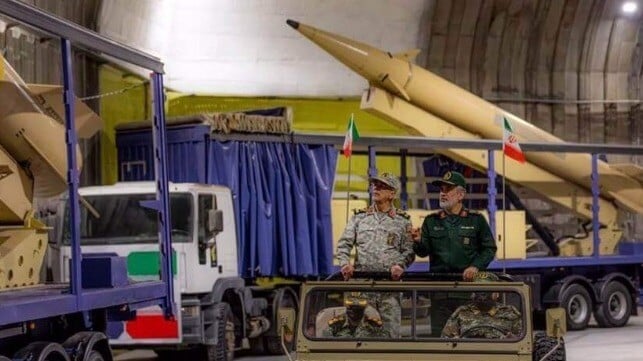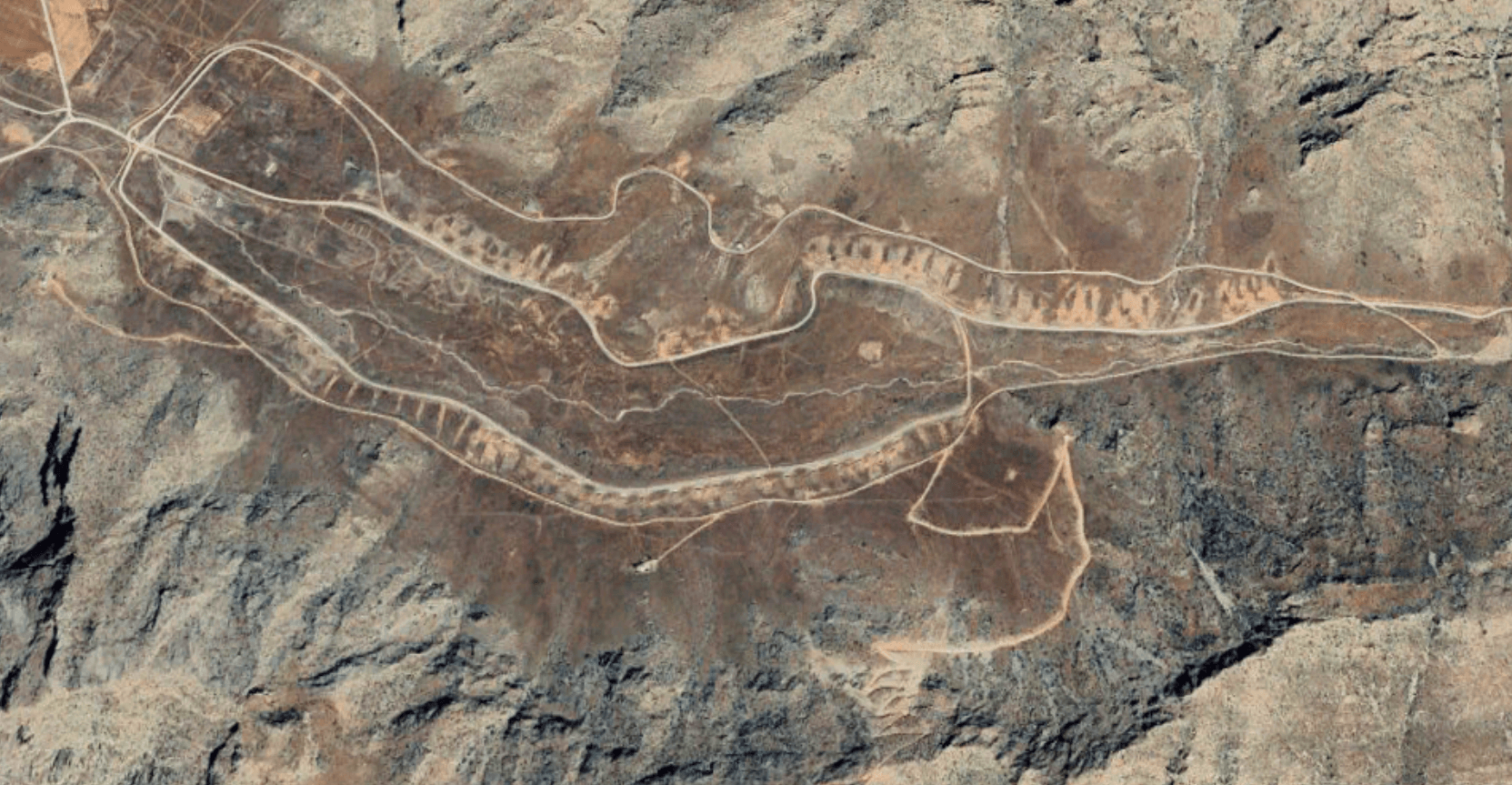Iran Has Thousands of Ballistic Missiles. Here's Where They Are.
If the U.S. Air Force and U.S. Navy carry out strikes on Iran, part of the Iranian missile inventory will likely survive the first wave.

The deployment of B-2 Spirit strategic stealth bombers and KC-135 refueling aircraft to Diego Garcia, plus the dispatch of the USS Carl Vinson to make up a second Carrier Strike Group in the region, make up only part of a well-publicized reinforcement of US forces in the Middle East region. With nations hosting US forces within the region anxious not to advertise an increased US presence, there will certainly be other reinforcements that have also been pushed forward into the region, particularly air defense assets, which have not been unveiled.
This forward deployment forms part of President Trump’s strategy to curb Iran, in which a diplomatic approach is accompanied by the implied threat of military force, should Iran not be willing to negotiate. Tightened sanctions on Iranian dark shipping and oil exports also form part of the strategy to put the Iranian regime under pressure, which is already acute because of decades-long sanctions and shortages of both water and other basic necessities. There are many indicators suggesting that as a consequence, the Iranian leadership is indeed feeling under intense pressure and quarrelling amongst themselves.
A general assumption is that the military pressure being applied on Iran is focused on permanently ending the threat of Iran developing nuclear weapons. Any first strike on Iran, should the diplomatic route fail, would likely be targeted on the Iranian nuclear program and the long-range missiles needed to weaponize this capability. It looks as if it is militarily feasible to destroy the nuclear weapons capability; every critical node and last detail of the program appears to be known to Western intelligence. General Petraeus, formerly Commander CENTCOM, has recently said that such an operation had already been successfully rehearsed.
But nuclear weapons are only half the problem. To achieve a durable peace, the United States is equally interested in putting an end to Iran’s decades-long attempt to expand its regional influence, through use of the Islamic Revolutionary Guard Corps (IRGC) Qods Force across the region and through the often-exercised threat posed by Iranian or Iranian proxy ballistic and cruise missiles. The Iranians contend that these regional influence efforts are non-negotiable.
Moreover, if a first strike was designed to destroy the Iranian nuclear weapons program, it would still leave Iran’s ballistic and cruise missile capability intact - and ready to be used in any counter-attack. Such a ‘devastating ‘counter-attack is often threatened by senior IRGC leaders.
Realistic military planning must deal not only with the Iranian nuclear weapons development program - but also the threat posed by Iran’s ballistic and cruise missiles, which present a formidable target not vulnerable to a decisive, knock-out first strike attack.
Iran has at least 24 identified missile sites in the western half of the country, spread from north to south. Some of these sites appear to be independent, others are arranged in clusters. All feature underground storage bunkers, from which both drone and missile mobile launchers can be driven out, ready to go into action within minutes. The site at Kermanshah Konesh Canyon has at least 60 such tunnel bunkers.
 More than 50 underground bunkers visible in the Kermanshah Konesh Canyon missile complex (Google Earth, June 6, 2024)
More than 50 underground bunkers visible in the Kermanshah Konesh Canyon missile complex (Google Earth, June 6, 2024)
Each site has multiple tunnel entrances, from which a further multiple of missiles or drones can be launched. Some sites also feature hardened silos with automated revolver carousels enabling the rapid reloading of ballistic missiles; the site at Haji Abad for example has at least seven silos, aligned for targets along the Bahrain-Riyadh axis.
The locations given in the site list attached are for site maintenance buildings. But using open source, freely available satellite imagery, in all locations tunnel entrances can be seen close by. There will certainly be many more such sites which have not been identified, and each site also has a garrison administrative area in the neighborhood, where there are likely to be more drones and missiles on mobile launchers.
|
CLUSTER |
LOCATION/SITE |
LAT |
LONG |
|
Bandar Abbas Area Independent Sites |
Bandar Abbas Khorgu |
27.528789N |
56.451021E |
|
Haji Abad |
28.328772N |
55.942649E |
|
|
Bandar Lengeh |
26.658735N |
54.893197E |
|
|
Lar |
27.643131N |
54.256253E |
|
|
Jam |
27.794144N |
52.318042E |
|
|
Garmdareh Cluster |
Garmdareh North West |
35.788410N |
51.059026E |
|
Garmdareh North East |
35.768729N |
51.085032E |
|
|
Isfahan Cluster |
Isfahan West |
32.695027N |
51.430270E |
|
Isfahan South |
32.459346N |
51.714619E |
|
|
Kashan (independent site or other sites nearby not detected) |
34.093362N |
51.255711E |
|
|
Kerman (independent site or other sites nearby not detected) |
30.239153N |
56.851713E |
|
|
Kermanshah Cluster
|
Kermansheh Panj Peleh |
34.360500N |
47.228508E |
|
Kermanshah Konesh Canyon |
34.389521N |
47.181043E |
|
|
Kermanshah South |
34.394788N |
47.222654E |
|
|
Kermanshah North East |
34.525045N |
47.361183E |
|
|
Kermanshah North West |
34.439950N |
47.187934E |
|
|
Kermanshah Shahid Montazeri Garrison |
34.482361N |
47.009583E |
|
|
Khorramabad Cluster |
Khorramabad Imam Ali NW |
33.581276N |
48.181536E |
|
Khorramabad Imam Ali SE |
33.564324N |
48.217238E |
|
|
Khorramabad Imam Ali Garrison |
33.552829N |
48.214824E |
|
|
Qom (independent site or other sites nearby not detected) |
34.943853N |
50.763649E |
|
|
Shiraz Cluster |
Shiraz North West |
29.726310N |
52.558080E |
|
Shiraz North |
29.707720N |
52.590671E |
|
|
Shiraz South |
29.473558N |
52.490816E |
|
|
Tabriz Cluster |
Khosroshah Garrison |
37.941000N |
46.025000E |
|
Tabriz North |
38.251449N |
46.119187E |
|
|
Tabriz South |
37.977313N |
46.176606E |
|
|
Yazd (independent site or other sites nearby not detected) |
31.803792N |
54.298661E |
|
Some of these sites were first constructed decades ago, when the short range of missiles then available meant that they could be targeted only against neighboring GCC countries, rather than Israel. As missile ranges have increased, probably all the sites are now capable of threatening Israel, as well as any American presence at Al Udeid (Qatar), Al Dhafra (UAE), Naval Base Bahrain, Dimona (Israel), Muwaffaq Salti (Jordan), Camp Arifjan (Kuwait) and Ain al-Assad (Iraq).
A recent video showing touring the visit of Major General Mohammad Bagheri and Brigadier Amir Ali Hajizadeh to a ‘missile megacity’ on March 25 showed a variety of missiles and drones parked up, including Ghadr (1,600 km range), Emad (1,800 km range), Haji Kassem (1,400 km range), Kheibar Shakan (1,450 km range) and Sejjil ((2,000 km range) medium range missiles plus long range Khorramshahr-4s (3,000 km range). Fattah-1 medium range missiles were not seen but featured heavily in Iran’s earlier True Promise attacks on Israel. Shahed-136B kamikaze drones have even longer ranges, and missiles and drones can also be launched from Iranian naval vessels such as the drone carriers Shahid Mahdavi (C110-3) and Shahid Bagheri (C110-4).
As well as the infrastructure to protect thousands of missiles and drones in hardened shelters, the IRGC also has a tactical playbook to help hide and disperse these systems, so that any attack on this overall capability cannot be entirely pre-planned and must have a tactical element to deal with fast-moving or elusive targets.
Even if a surprise attack on this huge target array was largely effective, hundreds of missiles and drones would likely escape destruction in any first wave. So attack plans will need to assume that successive attack waves will be needed to fully neutralize the threat. One might hope that at this juncture Iranian leaders might be willing to come to the negotiating table, or that the internal security apparatus might succumb to a domestic uprising. But neither response can be counted upon, and a worst-case scenario probably needs to be planned for.
The opinions expressed herein are the author's and not necessarily those of The Maritime Executive.
